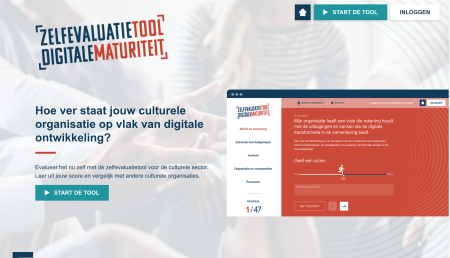Assessing the digital maturity of Flemish cultural organisations
2 Apr 2024Since 2019, the Digital Maturity Self-Assessment Tool has been helping cultural organisations to – you guessed it – gauge their digital maturity. At the end of 2021, we took a first look at the responses from the tool. Now, two years on, we’ve checked in again. So what’s changed in the meantime?
Constants, but also changes
We notice some similarities and differences compared to the previous analysis. On the whole, organisations rate their digital maturity slightly lower than we initially thought. They score 56 out of 100 on average, compared to 58 out of 100 two years ago.
What stands out? Arts organisations still rate themselves above the curve, though the gap with other sectors has narrowed since the first analysis. Cultural heritage organisations that manage collections have scored themselves higher than they did two years ago. And while the first analysis suggested that the size of an organisation was decisive in their self-assessment (the smaller the organisation, the better the score), this now turns out not to be the case. Large and small organisations each struggle with their own challenges, without necessarily rating themselves as more or less digitally mature across the board.
The larger amount of data therefore provides a more nuanced picture. But the increased share of the library sector in the responses is also noticeable, with higher scores for statements regarding aspects that libraries often focus on.
Strengths and areas for improvement
In short, the responses to the statements reveal that most organisations are already strongly committed to digital working and their visibility through online communication channels. The following statements scored the lowest – although there are significant differences among the respondents:
My organisation offers digital tools that enable its target audience to create digital content in a user-friendly way. The target groups participate digitally and become co-creators.
As the previous analysis pointed out, co-creation and digital participation are not high many organisations’ agendas. Some have already experimented with it (e.g. on social media or via Wikimedia platforms), some have ambitions in this area but have not yet started, and others indicate they simply have no plans in this regard.
My organisation clearly states whether the online content that it makes available can be re-used, and under what conditions.
Many organisations still find it a challenge to provide accurate information about the reuse of their online content, often because the copyright status of this content is not consistently indicated. Sometimes organisations have this information but software limitations prevent it from being disclosed, and a lack of in-house knowledge is also cited as a reason. Fortunately, there are also quite a few respondents who indicate they are actively working on this.
My organisation uses the evaluation data from digital interaction with its target groups to shape its digital strategy.
Some respondents are already fully utilising the statistics from their newsletters, social media and website as a tool in their digital strategy. Others have this data but do not analyse it or use the available information effectively. A lack of time is identified as the main obstacle. And sometimes this aspect is not even on the radar – despite good intentions.
To find out how digitally mature your organisation is, do the test (in Dutch).
Or, if you would prefer some guidance to fill in the tool, together with other organisations, please contact bart.magnus@meemoo.be and we’ll see if we can set up another guided filling session.

